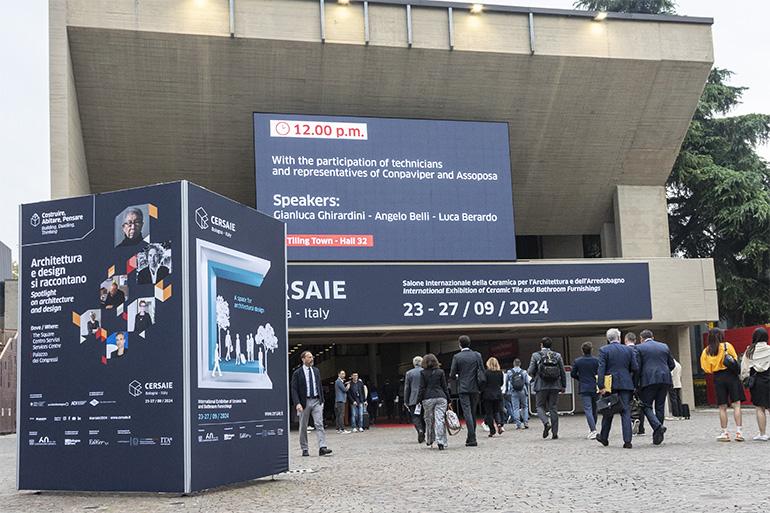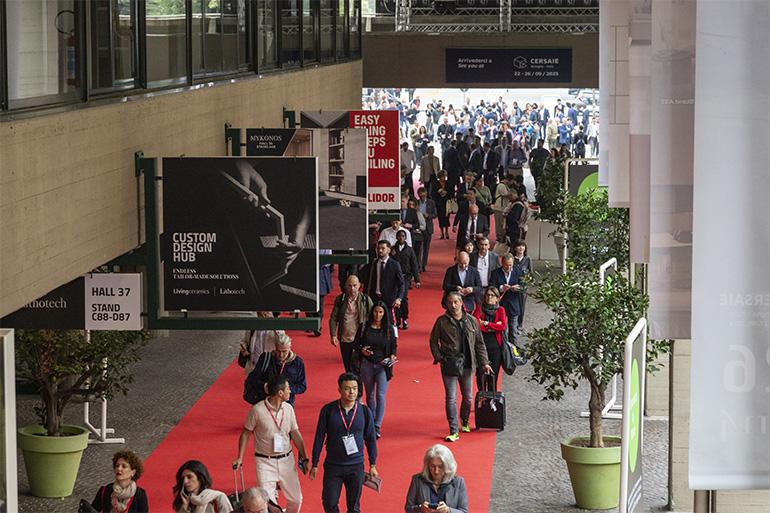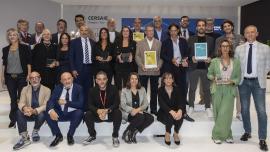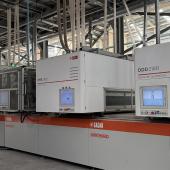Cersaie, 95,000 visitors and a focus on nuclear energy
The Bologna show has reaffirmed its status as the industry’s premier international event. Minister Pichetto Fratin at the inaugural conference: “We should consider mini nuclear reactors”.
With a total attendance of more than 95,000 visitors, almost 50% of whom came from abroad, Cersaie once again reaffirmed its status as the premier international event for the ceramic tile and bathroom furnishings industry. A total of 95,321 visitors were recorded over the five-day exhibition, a decrease of 4% compared to the previous year. This slight decline was the result of a relatively stable turnout of international attendees (47,095 compared to 47,634 in 2023, a drop of just 1%) and a 6.7% decrease in Italian visitors (48,226 compared to 51,685).
The 41st edition of the show, held in the Bologna exhibition centre from 23 to 27 September, occupied fifteen fully packed-out halls with a total floor space of 145,000 square metres. The event hosted 606 exhibitors, including 332 from the ceramic tile sector, 91 from the bathroom furnishings sector and 183 from installation, raw materials, new surfaces and service sectors. The exhibition maintained its strong international nature with 230 foreign exhibitors (38% of the total) from 25 countries.
“Despite the highly challenging international context, Cersaie’s exceptional capacity to attract visitors enabled exhibiting companies to really make the most of their investment in the show,” said Augusto Ciarrocchi, Chairman of Confindustria Ceramica. “The exhibitors were particularly impressed by the quality of the visitors present, including distributors, architects and real estate operators.”
Emilio Mussini, head of Promotional Activities at Confindustria Ceramica, summed up the extensive programme of events held at this year’s Cersaie, highlighting in particular the 1,200 participants at the Keynote Lecture given by Riken Yamamoto, the 13th Pritzker Prize winner to speak at Cersaie, the hundreds of architects attending the various events in the ‘Building, Dwelling, Thinking’ programme, and the strong interest and high turnout at Tiling Town.
The inaugural conference
Cersaie’s inaugural conference featured an interesting discussion about the future of the Italian ceramic industry, with a particular focus on the complex issue of alternative energy sources to natural gas, including hydrogen and nuclear power.
Entitled “The Energy Transition and International Competitiveness for the Italian Ceramic Industry”, the conference hosted prominent guest speakers, including the Italian Minister for the Environment and Energy Security Gilberto Pichetto Fratin, Confindustria Chairman Emanuele Orsini and Confindustria Ceramica Chairman Augusto Ciarrocchi.
“Today, we are witnessing a downturn in the market, exacerbated by the international crisis,” remarked Ciarrocchi. “We are also feeling the impact of the phasing out of the ‘superbonus’ tax incentive scheme. It’s a challenging period for everyone, but these companies continue to invest, raising the bar for quality and design.”
Ciarrocchi also highlighted the significance of the energy supply challenge, stressing the need to begin considering nuclear power as a serious option.
These words were echoed by Minister Pichetto Fratin, who stated: “With the demand for energy expected to double over the next 25 years, it is essential for us to explore alternative sources. Nuclear research and testing is a step we need to take, and we must establish a clear legislative framework. Perhaps by the next Cersaie, the ceramic industry will begin considering the potential of adopting small reactors.”
In his speech, Confindustria Chairman Emanuele Orsini also addressed the topic of nuclear power:
“Today, in Italy, we pay 40% more for energy than the European average. In the United States, energy costs €8 per megawatt-hour, while here it costs around €39-40. We can no longer avoid talking about nuclear power. Many of us still picture massive power plants, but things have now changed and enormous technological progress has been made. In Italy, we have world-leading companies conducting cutting-edge research, but they are forced to do so abroad due to the ban here. Micro-reactors could offer crucial support to businesses in our sector. We cannot keep relying on energy from French power stations that are just across the border.”
Marco Fortis, director of the Edison Foundation, offered another insightful perspective on Italy’s economic situation, particularly with regard to the ceramic sector.
“Never before has Italian manufacturing been so competitive,” he remarked. “In the first seven months of the year, we overtook Japan in terms of exports – a feat no one would have bet a euro on ten years ago. The ceramic tile industry is unquestionably one of our flagship sectors.”
The conference was also attended by Emilia-Romagna Regional Councillor for Economic Development Vincenzo Colla, the Chairman of the Italian Trade Agency ITA Matteo Zoppas, the CEO of Simest Regina Corradini D’Arienzo and the Chairman of BolognaFiere Gianpiero Calzolari.
Did you find this article useful?
Join the CWW community to receive the most important news from the global ceramic industry every two weeks




























